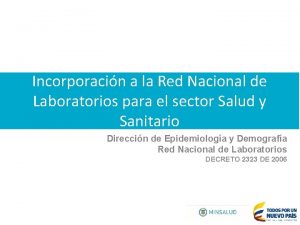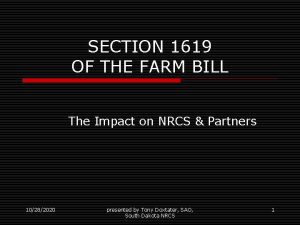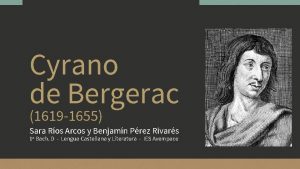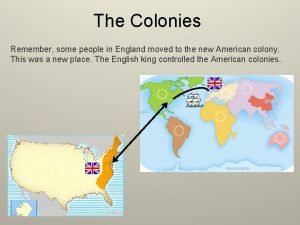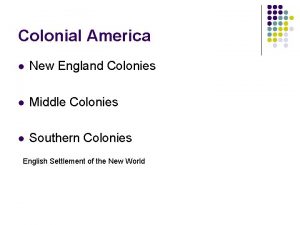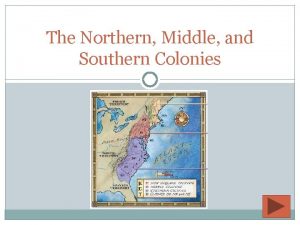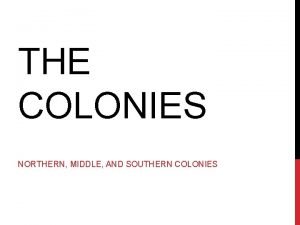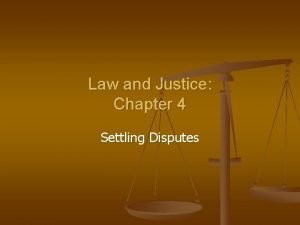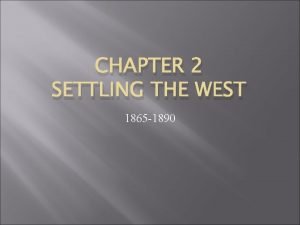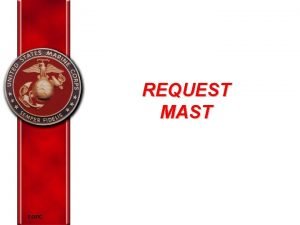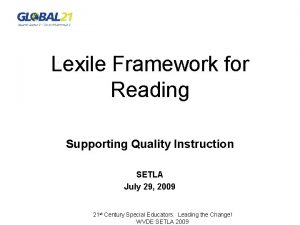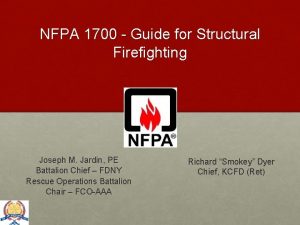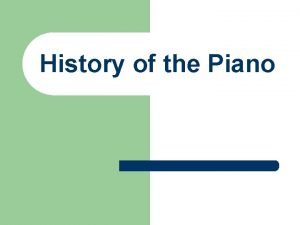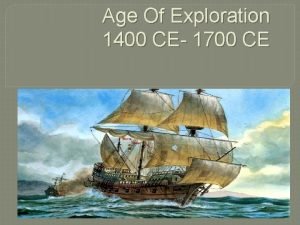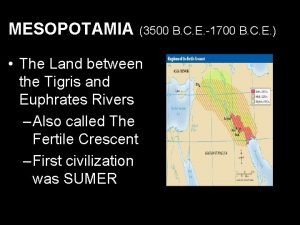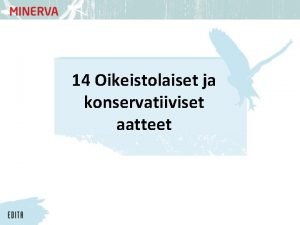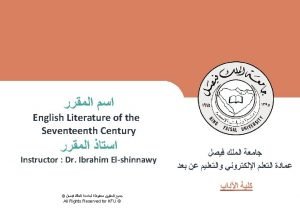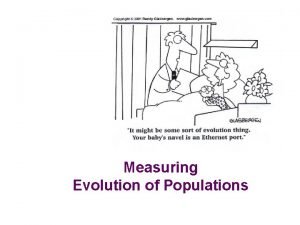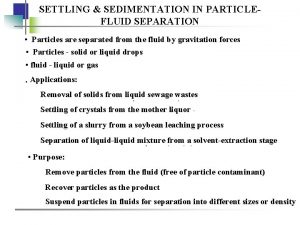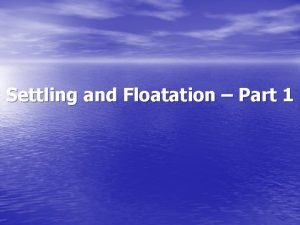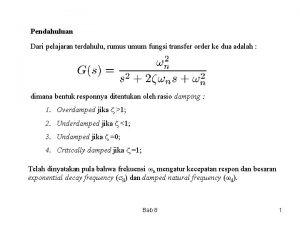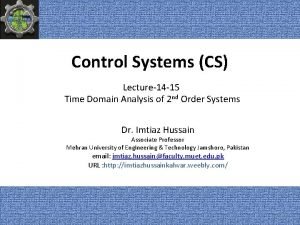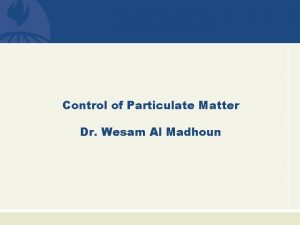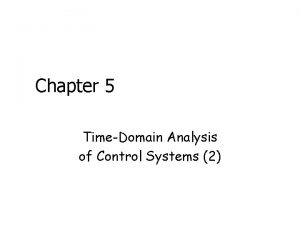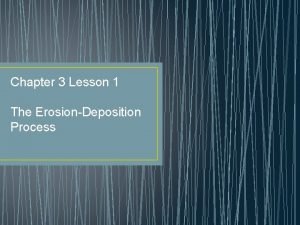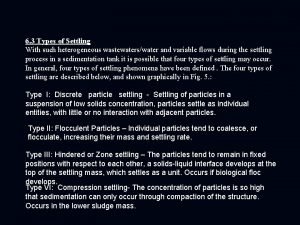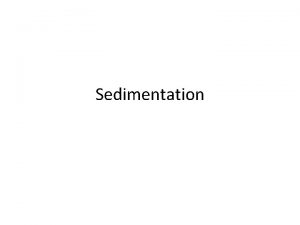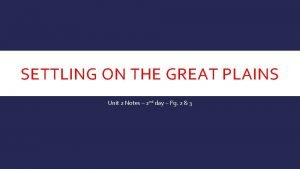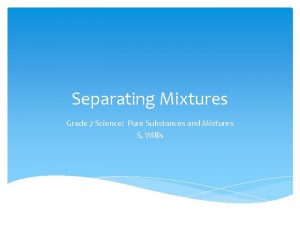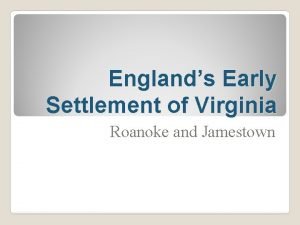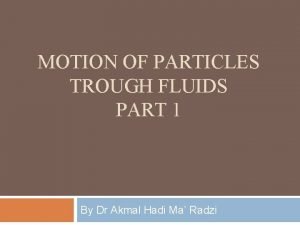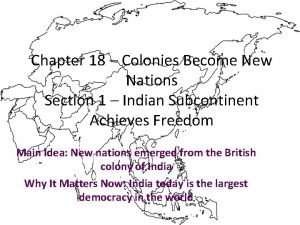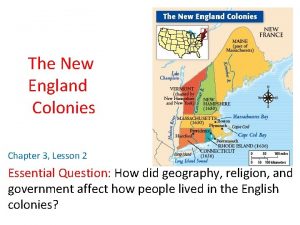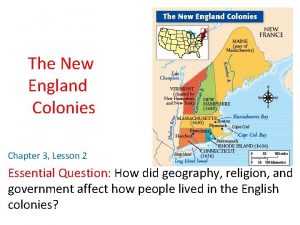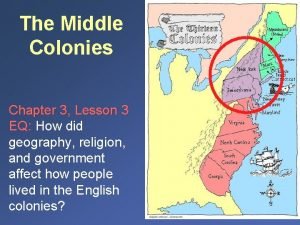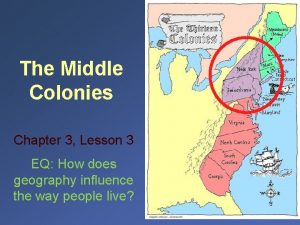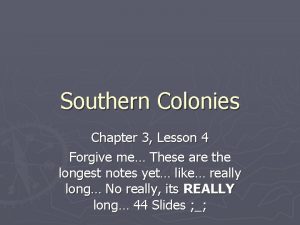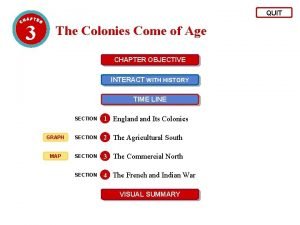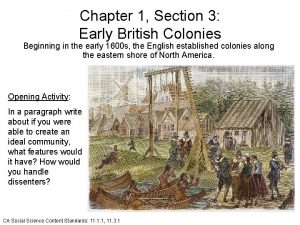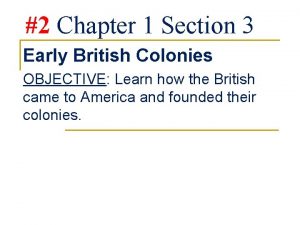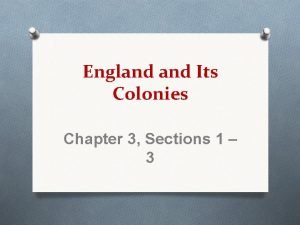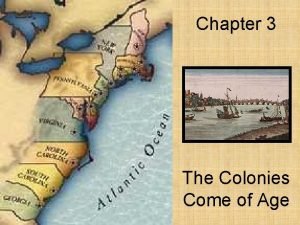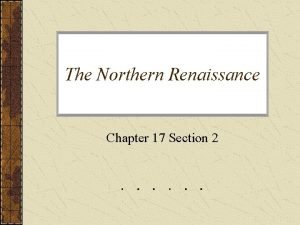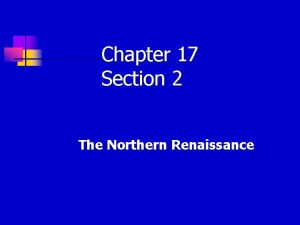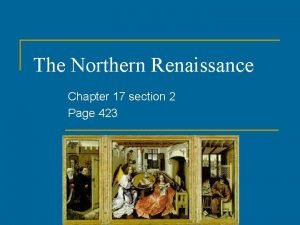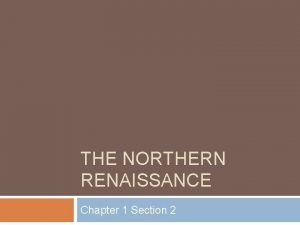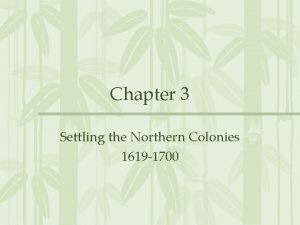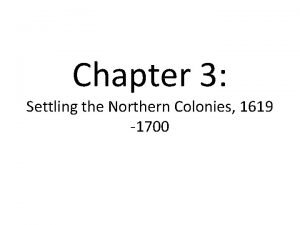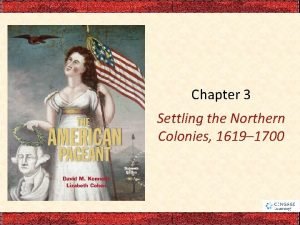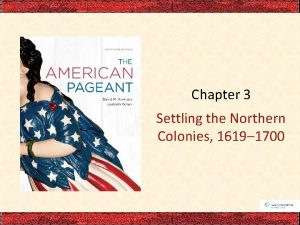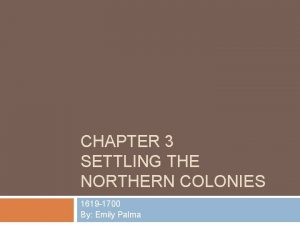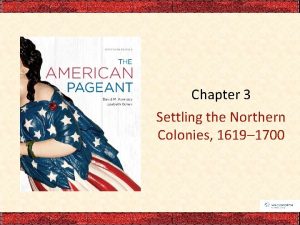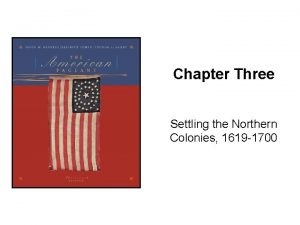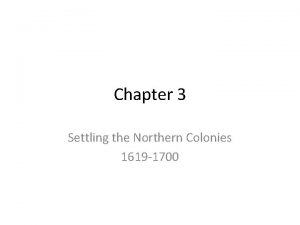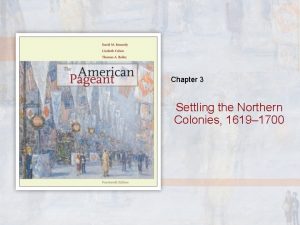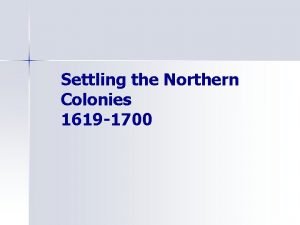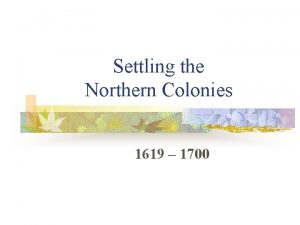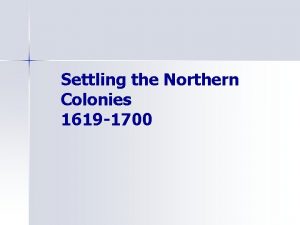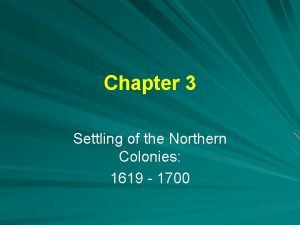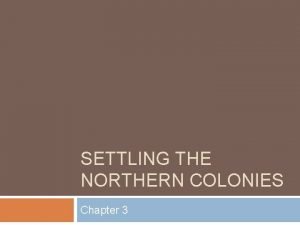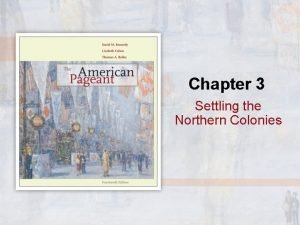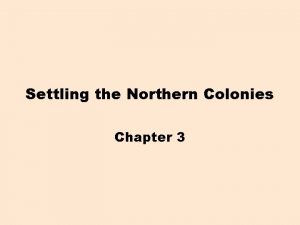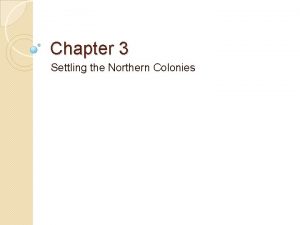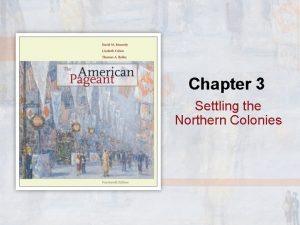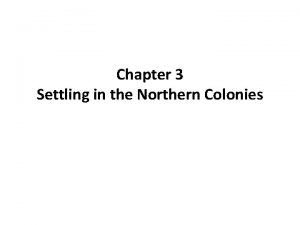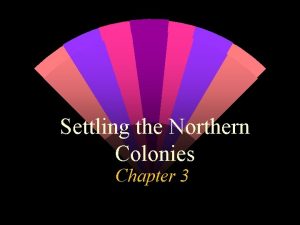Chapter 3 Settling the Northern Colonies 1619 1700































































- Slides: 63

Chapter 3 Settling the Northern Colonies 1619– 1700

I. The Protestant Reformation Produces Puritanism • 1517: Martin Luther began the Protestant Reformation. • John Calvin’s use of Luther’s ideas had a profound effect on the thought and character of America. • Calvinism became the dominant theological credo.

I. The Protestant Reformation Produces Puritanism (cont. ) • Major doctrines of Calvinism are predestination—the elect are destined for eternal bliss and others for eternal torment —and conversion—the receipt of God’s free gift. • 1530 s: King Henry VIII broke with the Catholic Church. • Puritans: English religious reformers who wanted to purify English Christianity.

I. The Protestant Reformation Produces Puritanism (cont. ) • Controversy over church membership led to the Separatists breaking from the Church of England. • King James I (r. 1603– 1625) threatened to harass the bothersome Separatists out of England.

II. The Pilgrims End Their Pilgrimage at Plymouth • 1608: First Separatists fled to Holland, but over time they became distressed by the “Dutchification” of their children. • 1620: Some Separatists (known as Pilgrims) sailed on the Mayflower to Plymouth Bay.

II. The Pilgrims End Their Pilgrimage at Plymouth • Their Mayflower Compact was an agreement to form a government and submit to the will of the majority under some regulations. • Small settlement survived difficult early years.

Plymouth Plantation p 43

III. The Bay Colony Bible Commonwealth • 1629: King Charles I dismissed Parliament and persecuted Puritans. • 1630: Puritans founded Massachusetts Bay Colony. • 1630 s: 70, 000 refugees left England during the Great Migration

Map 3. 1 a Sources of the Puritan “Great English Migration” to New England, c. 1620– 1640 The shaded areas indicate the main sources of the migration. Map 3. 1 a p 45

The Great English Migration, ca. 1630– 1642 Much of the early history of the United States was written by New Englanders, who were not disposed to emphasize the larger exodus of English migrants to the Caribbean islands. Map 3. 1 b p 45

III. The Bay Colony Bible Commonwealth (cont. ) • Like William Bradford in Plymouth, John Winthrop helped colony survive and prosper. • Winthrop believed he had a “calling” from God to lead the new religious experiment.

III. The Bay Colony Bible Commonwealth (cont. ) • The Massachusetts Bay Colony became the biggest and most influential colony. • The first colonists believed they had a covenant with God to build a holy society as a model for all humankind. (“City Upon a Hill”)

IV. Building the Bay Colony • Franchise (voting rights) was extended to all “freemen”—adult males who belonged to Puritan congregations. Unchurched men remained vote less. • The Bay Colony was not a democracy. • All paid taxes to support the church.

IV. Building the Bay Colony • Attitudes of the Puritans that we have inherited: – “Self-made man”/”meritocracy” – Protestant work ethic – Material success (& failure) – Respect for EDUCATION (Harvard est. in 1637) – Community involvement and improvement – Moral absolutism & religiosity – Separation of Church & State (Roger Williams & Rhode Island)

V. Trouble in the Bible Commonwealth • Quakers, who flouted the authority of the Puritan clergy, were persecuted. • Anne Hutchinson’s antinomianism carried to extremes the doctrine of predestination. • 1638: She was brought to trial, then banished. • She left for Rhode Island then moved to New York, where she and her family were killed by Indians.

Anne Hutchinson (1591– 1643) held unorthodox views that challenged the authority of the clergy and the very integrity of the Puritan experiment in the Massachusetts Bay Colony. An outcast in her day, she has been judged a heroine in the eye of history. This statue in her honor, erected in the nineteenth century, now graces the front of the Boston, Massachusetts, Statehouse. p 46

V. Trouble in the Bible Commonwealth (cont. ) • Roger Williams was an extreme Separatist. • He challenged the civil (government’s) authority to regulate religious behavior. • 1635: He was tried by the authorities & banished from Massachusetts.

VI. The Rhode Island “Sewer” • 1636: Williams, with the aid of Indians, fled to Providence (Rhode Island). • He built a Baptist church. • He established freedom of religion, even for Jews & Catholics, & separation of church and state. • He sheltered abused Quakers. • Rhode Island became the most liberal colony.

VII. New England Spreads Out • The fertile Connecticut River area attracted a sprinkling of Dutch and English settlers. • 1635: Hartford was founded. • 1639: Connecticut’s Fundamental Orders was a modern constitution with democratic control by “substantial” citizens. • 1638: New Haven was founded by Puritans (merged with CN in 1662).

Map 3. 2 p 48

VII. New England Spreads Out (cont. ) • 1677: Maine was absorbed by Massachusetts. • 1641: New Hampshire was absorbed by the Massachusetts Bay Colony. • 1679: King Charles II separated New Hampshire from Massachusetts and made it a royal colony.

VIII. Puritans Versus Indians • 1620: Before Pilgrims arrived, an epidemic killed over 75% of the people. • Wampanoag Indians befriended the Pilgrims. • 1621: Wampanoag chieftain Massasoit signed a treaty with the Plymouth Pilgrims & the 1 st Thanksgiving was celebrated.

VIII. Puritans Versus Indians The first Thanksgiving 1621 (painted by J. L. G. Ferris circa 1932)

VIII. Puritans Versus Indians The first Thanksgiving 1621—A different perspective

VIII. Puritans Versus Indians • Expanding settlement increased tensions. • 1637: Pequot War-- almost destroyed Pequot tribe, showing that only a pan-Indian alliance could hope to stop the English settlers from moving west.

VIII. Puritans Versus Indians • 1675: Massasoit’s son Metacom (King Philip) forged intertribal alliance to resist settlers. • 1675– 1676: King Philip’s War slowed English settlement for a time, but overall inflicted a lasting defeat on Indians in New England. • Depiction of Metacomet, also known as King Philip of Wampanoag, by American silversmith and engraver Paul Revere.


p 49

IX. Seeds of Colonial Unity and Independence • 1643: Four colonies formed New England Confederation. • Its primary aim was defense against foes. • Each colony had two votes. • The confederation was essentially an exclusive Puritan club. • It was a milestone toward colonial unity.

IX. Seeds of Colonial Unity and Independence (cont. ) • Distracted by the English Civil War, England exercised benign neglect in the colonies. • As a result, colonists developed habits of relative independence. • 1660: King Charles II was restored and wanted to impose a much more active management of the colonies.

Table 3. 1 p 50

IX. Seeds of Colonial Unity and Independence (cont. ) • Massachusetts resisted Charles’s efforts. • 1662: Charles gave Connecticut a sea-to-sea charter that legalized squatter settlements. • 1663: He granted the outcasts in Rhode Island a new charter sanctioning religious tolerance. • 1684: London authorities revoked the Bay Colony’s charter.

X. Andros Promotes the First American Revolution • 1686: Royal authority created the Dominion of New England (see Map). • Sir Edmund Andros headed the Dominion.

Navigation Laws • The Navigation Acts were a series of laws in the mid-1600 s that restricted colonial trade. • They reflected the policy of mercantilism, which sought to keep all the benefits of trade inside the Empire, and to minimize the loss of gold and silver to foreigners. • They prohibited the colonies from trading directly with the Netherlands, Spain, France, and their colonies.

X. Andros Promotes the First American Revolution (cont. ) • Andros generated hostility by his actions against self-government as well as smuggling. • 1688– 1689: The Glorious Revolution overthrew Catholic James II; enthroned Protestant rulers William III and Mary II. • The Glorious Revolution caused the collapse of the Dominion of New England. • It also gave Parliament significantly more power (taxation, military, etc. )

Sir Edmund Andros (1637– 1714) After being expelled from New England, Andros eventually returned to the New World as governor of Virginia (1692– 1697). p 51

X. Andros Promotes the First American Revolution (cont. ) • Many colonies struck against royal authority, including New York and Maryland. • In response, the new monarchs began a period of “salutary neglect” in enforcing the hated Navigation Acts. • Residues remained of Charles II’s effort to assert tighter colonial administrative control. • Many English officials were sent to colonies.

XI. Old Netherlanders at New Netherland • 1623– 1624: New Netherland was founded in the Hudson River area. • purchased Manhattan Island from the Indians. • New Amsterdam—later New York City—was a town run by the Dutch West India Company.

XI. Old Netherlanders at New Netherland (cont. ) • The investors had no enthusiasm for democratic practices. • A local body with limited lawmaking power was eventually established. • The colony developed a strong aristocracy as patroonships (feudal estates) were built. • New Amsterdam attracted a cosmopolitan population.

p 53

XII. Friction with English and Swedish Neighbors • The Dutch company-colony was beset by problems, especially with the Indians. • Settlers on Manhattan Island erected a wall, from which Wall Street derived its name.

XII. Friction with English and Swedish Neighbors (cont. ) • 1638– 1655: Swedes trespassed on Dutch claims by planning New Sweden on the Delaware River (see Map 3. 4). • 1655: Resenting the Swedes, the Dutch dispatched a small military expedition. • Peter Stuyvesant successfully absorbed New Sweden into New Netherland.

XIII. Dutch Residues in New York • 1664: England seized New Netherland from the Dutch. • Charles II had granted his brother, the Duke of York, the former New Amsterdam area. • New Amsterdam was renamed New York. • England gained a splendid harbor and the stately Hudson River.

XIII. Dutch Residues in New York (cont. ) • The English banner now waved over a stretch of territory from Maine to the Carolinas. • New York retained an autocratic spirit. • The Livingston and De Lancey families wielded disproportionate power. • This lordly atmosphere discouraged many European immigrants from coming.

XIII. Dutch Residues in New York • Dutch influence: – Place names (Wall street, Brooklyn, Harlem) – Gambrel-roofed architecture – Social customs and folkways— lots of parties and eating (Easter eggs, Santa Claus, drinks at New Years party), bowling, skating, sleighing, golf – Food: doughnuts (ole kooks = oily cakes), cookies, crullers, waffles and sauerkraut.

p 54

XIV. Penn’s Holy Experiment in Pennsylvania • Quakers, English dissenters known as the Religious Society of Friends: – refused to pay taxes for the established Church of England. – built simple meeting houses. – congregated without a paid clergy. – “spoke up” in meetings when moved. – kept their broad-brimmed hats on in the presence of “betters. ”

XIV. Penn’s Holy Experiment in Pennsylvania • Quakers (cont. ): – Addressed each other with simple “thee”s and “thou”s. – Took no oaths. • They were people of deep conviction: – Abhorred strife and warfare – Refused military service – Advocated passive resistance

• Quakers, or Friends, were renowned for their simplicity of architecture, dress, manner, and speech. • They also distinguished themselves from most other Protestant denominations by allowing women to speak in Quaker meetings and to share in making decisions for the church and the family.

p 55

XIV. Penn’s Holy Experiment in Pennsylvania (cont. ) • 1660: William Penn was attracted to the Quaker faith and suffered much persecution. • Penn’s thoughts turned to the New World. • He wanted to experiment with liberal ideas in government and to make money.

XIV. Penn’s Holy Experiment in Pennsylvania (cont. ) • 1681: He secured land from the king. • The king called the land Pennsylvania (“Penn’s Woodland”). • Pennsylvania was the best-advertised colony. • His liberal land policy also attracted many immigrants.

XV. Quaker Pennsylvania and Its Neighbors • 1681: Penn launched his colony: – Dutch, Swedish, English, and Welsh “squatters” were already there. – Philadelphia was carefully planned. – He bought land from the Indians and treated them fairly. • Pennsylvania seemed, for a brief time, the land of amicable Indian -white relations.

p 56

XV. Quaker Pennsylvania and Its Neighbors (cont. ) • Quaker tolerance of non-Quaker immigrants eventually undermined Penn’s Indian policy. • Penn’s proprietary regime was unusually liberal and thus attracted many immigrants: – Representative assembly elected by landowners – No tax-supported state church – Freedom of worship – Restricted use of death penalty

XV. Quaker Pennsylvania and Its Neighbors (cont. ) • “Blue laws” prohibited “ungodly revelers, ” stage plays, playing cards, dice, games, and excessive hilarity. • The Quakers were shrewd businesspeople. • By 1700 the colony surpassed all other colonies but Virginia and Massachusetts in population and wealth. • Penn spent only four years in the colony.

XV. Quaker Pennsylvania and Its Neighbors (cont. ) • Noted features of the colony: – No provision for a military defense (anti-war) – No restrictions on immigration – Strong dislike of slavery – Social reform/civil rights promoters – Many different ethnic groups – Afforded economic opportunity, civil liberty, and religious freedom


XVI. The Middle Way in the Middle Colonies • Common features of New York, New Jersey, Delaware, and Pennsylvania: – They had extensive fertile soil. – They became the “bread colonies” because of grain exports. – Rivers like the Susquehanna, the Delaware, and the Hudson tapped the interior fur trade. – Industry stimulated commerce and the growth of seaports like New York and Philadelphia.

XVI. The Middle Way in the Middle Colonies (cont. ) • The middle colonies were midway between New England the southern plantations: – Landholding was intermediate in size. – Local government was between personalized town meetings of New England diffused county government of the South. – They had fewer industries than New England, but more than the South.

XVI. The Middle Way in the Middle Colonies (cont. ) • Distinctions of their own: – A more ethnically mixed population – An unusual degree of religious toleration and democratic control – Desirable land that was easier to acquire – Considerable economic and social democracy • All American colonies flourished under Britain’s continuing hands-off policies.

p 58

p 61
 Red de laboratorios nacionales
Red de laboratorios nacionales Farm tools 1619
Farm tools 1619 Sara ja6
Sara ja6 North middle and southern colonies
North middle and southern colonies When was the new england colonies founded
When was the new england colonies founded Southern colonies
Southern colonies Southern colonies
Southern colonies Chapter 4 settling disputes
Chapter 4 settling disputes Settling the west 1865-1890
Settling the west 1865-1890 Mco1700.23f
Mco1700.23f Lexile score calculator
Lexile score calculator Nfpa 1700
Nfpa 1700 1700 piano
1700 piano 1700 ce
1700 ce Dynastic cycle def
Dynastic cycle def Esapideak zerrenda
Esapideak zerrenda Rivoluzione agricola 1700
Rivoluzione agricola 1700 1700 luvun aatesuunta
1700 luvun aatesuunta Rotazione quadriennale rivoluzione industriale
Rotazione quadriennale rivoluzione industriale Puritan age in english literature
Puritan age in english literature To resize an embedded chart ____
To resize an embedded chart ____ 1 in 1700 us caucasian newborns have cystic fibrosis
1 in 1700 us caucasian newborns have cystic fibrosis Mobility express bundle
Mobility express bundle 1700 bce
1700 bce Where can we find rotating arm sprays in sewage treatment
Where can we find rotating arm sprays in sewage treatment Settling velocity stokes law
Settling velocity stokes law Solid spherical particles of coffee extract from a dryer
Solid spherical particles of coffee extract from a dryer Differential settling method
Differential settling method Examples of floating and settling
Examples of floating and settling Rumus overshoot
Rumus overshoot Gravitational settling chamber
Gravitational settling chamber Clarifier tank in wastewater treatment
Clarifier tank in wastewater treatment Fcs underdamped graph
Fcs underdamped graph Input system output
Input system output Wesam al madhoun
Wesam al madhoun First order system equation
First order system equation Laying down or settling of eroded material
Laying down or settling of eroded material Gravitational settling chamber
Gravitational settling chamber Types of settling
Types of settling Settling velocity
Settling velocity An ideal horizontal flow settling basin
An ideal horizontal flow settling basin Settling on the great plains section 2
Settling on the great plains section 2 Floating and settling
Floating and settling Late charges in front office
Late charges in front office Settling jamestown
Settling jamestown Settling the west part 2 packet- farming the plains
Settling the west part 2 packet- farming the plains Settling velocity formula
Settling velocity formula Yshss
Yshss The colonies become new nations
The colonies become new nations The indian subcontinent achieves freedom
The indian subcontinent achieves freedom Lesson 2 the new england colonies
Lesson 2 the new england colonies Chapter 3 lesson 2 new england colonies answer key
Chapter 3 lesson 2 new england colonies answer key Government of the middle colonies
Government of the middle colonies Guided reading lesson 3 the middle colonies
Guided reading lesson 3 the middle colonies Chapter 3 lesson 4 the southern colonies
Chapter 3 lesson 4 the southern colonies The colonies come of age answer key
The colonies come of age answer key Chapter 1 section 3 early british colonies
Chapter 1 section 3 early british colonies Chapter 1 section 3 early british colonies
Chapter 1 section 3 early british colonies Chapter 3 section 1 england and its colonies
Chapter 3 section 1 england and its colonies Chapter 3 the colonies come of age
Chapter 3 the colonies come of age Northern renaissance literature
Northern renaissance literature Chapter 17 section 2 the northern renaissance answer key
Chapter 17 section 2 the northern renaissance answer key Chapter 17 section 2 the northern renaissance
Chapter 17 section 2 the northern renaissance Where did the northern renaissance began
Where did the northern renaissance began
